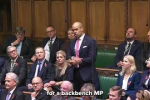
Lisa Nandy’s open defiance in visiting a picket-line was a damning indictment of how little authority the Labour leader now has
For a Labour leader consistently criticised for his failure to articulate what he really stands for, the last week has at least provided clarity on what Keir Starmer doesn’t.
First went the ten pledges he stood on to win the Labour Party leadership contest, a move of considerable chutzpah, as he tore up the mandate he was elected on while warning the Conservative Party leadership candidates not to do the same. Then came the latest round of industrial action from the unions. Starmer’s determination to drag the Labour Party to the centre saw him decide that this was where he was prepared to stand his ground, even if conditions underfoot were questionable.
“The Labour Party in opposition needs to be the Labour Party in power and a government doesn’t go on picket lines”; words likely to become oft-quoted should Keir Starmer remain Labour leader up to the next General Election, a situation by no means guaranteed. The burgeoning row over whether Shadow front-benchers are permitted to support industrial action has somehow blindsided Starmer, exposing both his political naivety and that of the team advising him.
Lisa Nandy’s open defiance in visiting the CWU picket-line in her constituency was a damning indictment of how little authority Keir Starmer now has as leader of the Labour Party. She wasn’t sacked, nor clearly did she fear being. A subtle repositioning by Starmer’s office followed in order to ensure that Nandy’s actions could avoid awkward condemnation, and with it the latest embarrassing act of rebellion from the left of the Party.
Contrast this with the impetuous sacking last week of Shadow Transport Minister Sam Tarry and Starmer has once again found himself to be a man without the courage of his ambivalence. Tarry is already facing deselection by his Constituency Labour Party. He is also a member of the Socialist Campaign Group, a veritable who’s who of far-left MPs including Jeremy Corbyn, Diane Abbott and John McDonnell, a collective handbrake on Starmer’s drive to the centre. Notably other SCG members include Apsana Begum, also facing deselection, and Kate Osamor, who narrowly survived a deselection vote last week. Their excision is clearly a coordinated move; Starmer decided Tarry’s sacking was too tempting an opportunity to miss.
A further boon for Starmer is that Tarry is the new partner of Angela Rayner. His indiscretion in so publicly undermining his Deputy Leader illustrates a petulant refusal to build a consensus within his own leadership team. In seizing the opportunity for fleeting success by scoring points against the left of the Party he has left himself open to criticism from those in Labour supportive of the unions and has invited challenges to his authority by those, like Nandy, he dare not sack and those, like Andy Burnham, he can’t.
It seems likely that several motions will be tabled at the Labour Party Conference, only six weeks away, forcing Starmer to reluctantly support any industrial action going forward. Coupled with speculation that unions plan to slash their funding to Labour, withdrawing their confidence and backing, and with it the millions required to furnish Labour’s election war-chest, it is difficult to see how Starmer’s position can remain tenable for long. As his waning authority continues to suffer a death by a thousand cuts, Labour MPs across the Party’s political spectrum will be asking themselves whether his regular mis-steps are compatible with the leadership that the Labour Party needs, or whether this transitional phase has run its course. A becalmed Labour Party leader who appears to stand for nothing, Starmer has failed to make any decisive gains against a leaderless Conservative Party. He has resolutely failed to define a vision for the country he claims Labour are ready to govern.
Whatever the outcome of the Conservative leadership contest Keir Starmer faces a very different challenge to the one he faced in Boris Johnson. In a little over a month he will face a new opponent, with momentum and the attention of the electorate. Using this time to fuel yet more internecine strife between Labour’s warring ideological factions can only benefit the Conservative Party.




